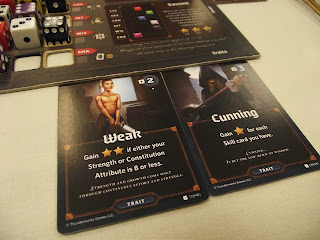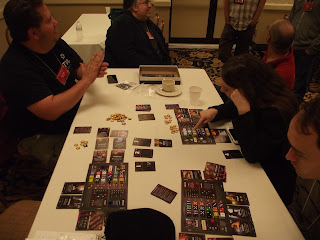 |
| Roll Player Designer: Keith Matejka Publisher: Thunderworks Games |
Disclaimer
A couple of weeks ago at Protospiel Madison I was playing games with Keith Matejka (the designer of Bullfrogs, one of my favorite abstract games, with a theme) and a few other designers and playtesters. Conversation shifted to the actual production and manufacturing processes in board game publishing, as well as how prototypes are made. Keith pulled out his prototype of Roll Player, which he had hand cut 18 die sized holes in 4 different player boards. The game piqued my interest and we agreed to play it then and there so that I could review it. Unfortunately I only got one play in, but I took lots of pictures and think I have a great feel for the game, too. I'm definitely looking forward to getting more plays in sometime in the future.
And that future will hopefully not be too long off. On November 10th Roll Player will hit Kickstarter at a $45 pledge level to get the game. http://kck.st/1SFOwvM This is Keith's second game that he's self publishing with help from Kickstarter funding. The first was Bullfrogs, an abstract strategy game that I absolutely love. The artwork in Bullfrogs is awesome, the gameplay is simple, solid, and very deep, and the game is a ton of fun. But enough about Bullfrogs, let's see how Roll Player stacks up. Is it another hit, or a sophomore slump? Well, I guess I kind of gave it away in the last sentence of my previous paragraph; this is bound to be another hit.
>> Check out the Campaign on Smarter Backer <<
Overview:
So, Roll Player is a dice game for 2-4 players, aged 10+ that should take 60-90 minutes. And there are lots of dice. Lots and lots of dice. 73 to be exact. And these aren't chintzy 12mm dice, they're big, bulky 16mm dice. There are also player boards and plenty of cards, too. I only played a prototype, but if Bullfrogs is any indicator they'll all be top quality.
 |
| Keith Matejka explaining how to play Roll Player. |
But, though there are lots of dice in Roll Player, there's very little luck. This game isn't about getting lucky with good dice rolls, it's about using the dice to your best advantage and manipulating them to create your own unique character. Roll Player takes the whole process of creating a character for an RPG and moves it to a tabletop game that includes player interaction, important decisions, and plenty of puzzly goodness.
Gameplay:
In RPG each player starts with a character. There are four main character races: Human, Elf, Dwarf, and Halfling. Each of the characters will be assigned a Class, Backstory, and Alignment. Class will be something like Monk, Wizard, Warrior, or Paladin. Backstory will tell you a little bit about your character, like is he a Hunter, Brawler, Savant, or Aristocrat? And the Alignment will tell you how Lawful or Chaotic, Good or Evil your character is, again with a characteristic like Champion, Hermit, or Eccentric. These three, randomly assigned characteristics make up your character. Each character also has six attributes: Strength, Dexterity, Constitution, Intelligence, Wisdom, and Charisma. None of these traits has a value at the beginning of the game, and that's where the dice come in.
 |
| During setup each player gets to seed their player's Attributes with a number of dice drawn and rolled. Throughout the game they'll work on fleshing out their characters' abilities. |
The object of the game is to build your character by collecting dice and assigning them to your character's attributes. The Class of your characters indicates the strength each Attribute must have by the end of the game, while the Backstory indicates where certain colored dice should be placed in the dice matrix on your player board in order to score bonus points.
Through a series of rounds (the number will differ based on the number of players), players will build their characters. They'll add value to their attributes, acquire skills, purchase weapons and armor, and gain traits. Each round is divided into four phases, most of which can be done simultaneously by players.
 |
| When characters are finished you really want to send them out on an adventure... Hmmm... I smell expansion material! |
The first phase is the Roll Phase. During the Roll Phase the starting player for the round (it changes every round) draws dice from a draw bag equal to the number of players plus one and rolls them. These are then placed on Initiative cards in sequential order.
Next comes the Dice Phase. Beginning with the starting player each player chooses an Initiative card along with the die that was placed on it (and any gold coins if there happen to be any). This indicates the order the player will go in the next phase, but as soon as a player has chosen an Initiative card the next player may proceed while the previous is completing the Dice Phase. Once the player takes a die they must place it on the leftmost space on their player board for one of their Attributes. Then they may take the action allowed by that Attribute. Strength lets the player flip any die on their board to its opposite side. Dexterity lets you swap the locations of any two dice on your board. Constitution lets you adjust any die value up or down one. Intelligence lets you reroll one die and keep either its new or prior value. Wisdom lets you adjust your Alignment marker one space in any direction. And Charisma gives you a one gold discount on any purchase in the next Market Phase. Filling an Attribute's row lets the player collect one gold coin and placing a gold die nets the player two gold coins.
 |
| As dice are placed, players get to take the actions each Attribute allows. |
Once all players have placed their dice the Market Phase can begin. There will be cards laid out equal to the number of players plus one in a market. The cards will be various types of weapons, skills, traits, and armor that players can acquire to bolster their players' abilities. Each card will have a cost and some will result in a shift in the character's Alignment when purchased. Purchasing cards happens in Initiative order. Each type of card gives your character unique abilities or goals. For example, the Pickpocket skill lets you decrease one die's value to gain two gold, but you also have to move your Alignment one space toward Evil (skills can be used at any point in a player's turn provided they have space in the Alignment grid to move). The Ancient Spear is a weapon that allows you to collect an extra gold coin every time you choose an Initiative card with gold on it. There are several types of Armor and they'll give you bonus points at the end of the game depending on how much of each set you've collected. And the trait Cunning gives you bonus points for every Skill card you have at the end of the game. Other cards have a wide range of other abilities.
 |
| Skills give your character new abilities that can be used, but influence your character's Alignment. |
 |
| Weapons give you passive abilities that take effect when certain situations occur. |
 |
| Traits affect how you are able to score points at the end and can shape your strategy. |
The game ends when everyone has filled their Attributes to capacity. Then scores are tallied based on a bunch of different criteria. The winner is the player with the highest score.
 |
| The game is over, now it's time to tally scores. |
 |
| I ended up with 30 points, respectable, but not enough to win. 39 points won, last place was 27 points. |
Mechanically the game is pretty simple. Strategically there's quite a bit going on. There is some luck involved, but there are so many options and choices to be made that the luck is very easy to mitigate, although the decisions on the best way to mitigate that luck aren't very easy. I never felt, throughout the entire game, that I was in a bad position because of how the dice fell. Yes, I occasionally didn't get what I wanted, but that was usually just because of someone else managing to get it before me. With 4 possible Characters, 12 Classes, 12 Backstories, and 13 Alignments there are virtually endless combinations. If my math is correct, 7,488 possible character combinations, and in a four player game there are 14,854 different starting combinations. That's quite a variety and if stretch goals are hit in the campaign that'll only increase.
 |
| Everyone had fun! I'm looking forward to a chance to play again! |
So yes, I really enjoyed playing Roll Player. The theme felt very well integrated with the mechanics. The gameplay was very solid. I always felt like I had important decisions. And the ultimate winner wasn't apparent until the very end. This is definitely a game on par with Bullfrogs for fun, strategy, theme, and overall gameplay. It's quite a bit bigger (73 dice take up a lot of room) than Bullfrogs, but at only $45 on Kickstarter it will make an excellent addition to any gamer's collection (and for only $25 more you can grab a copy of Bullfrogs, too). So be sure to check out the Kickstarter campaign, starting November 10th at http://kck.st/1SFOwvM.
 |
| Each player had a very different strategy and some worked better than others. |
Preliminary Rating: 8/10
This review is of a prototype game. Components and rules are not final and are subject to change.
Did you like this review? Show your support by clicking the heart at Board Game Links
 , liking GJJ Games on Facebook
, liking GJJ Games on Facebook  , or following on Twitter
, or following on Twitter  . And be sure to check out my games on Tabletop Generation.
. And be sure to check out my games on Tabletop Generation.GJJG Game Reviews are independent, unpaid reviews of games I, George Jaros, have played with my family and friends. Some of these games I own, some are owned by friends, some are borrowed, and some are print and play versions of games. Where applicable I will indicate if games have been played with kids or adults or a mix (Family Play). I won't go into extensive detail about how to play the game (there are plenty of other sources for that information and I'll occasionally link to those other sources), but I will give my impressions of the game and how my friends and family reacted to the game. Quick Reviews will only get a single rating of 1-10 (low-high) based on my first impressions of the game during my first few times playing. Hopefully I'll get more chances to play the game and will be able to give it a full review soon.










No comments:
Post a Comment